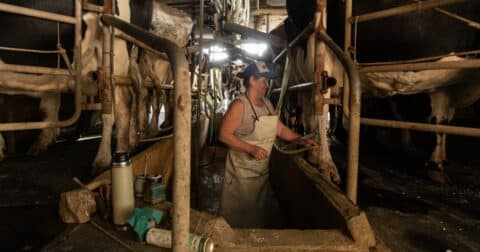News
Veganuary Hopes You’ll Resolve to Ditch Meat, at Least for One Month
Diet•4 min read
Reported
How bird flu puts vulnerable workers at even greater risk.


Words by Julieta Cardenas
Public health officials have been closely tracking bird flu spread in the United States for months now. The H5N1 virus has passed from chicken to cow to human, and three people exposed to sick dairy cows have so far become infected. Now, a new study finds that the bird flu virus can linger on milking equipment for up to an hour.
The Centers for Disease Control continue to describe the risk to humans as low, given the absence of human-to-human transmission, but this study suggests that dairy workers are particularly vulnerable to infection. We already knew that workers in the poultry industry were most at risk, as they spend a significant amount of time around birds. But this new study adds evidence that dairy workers are also at risk of infection. After all, the first person to test positive for this most recent strain of bird flu works in the dairy industry, and is believed to have caught it from a cow.
There are over 60,000 dairy farms in the U.S., with the top three dairy producing states being California, Wisconsin and New York. According to the International Dairy Foods Association, U.S. dairy supports more than 3 million American jobs, including workers on dairy farms who regularly handle milking equipment. Sick cows are still being milked, which means workers on farms where the virus is spreading are continuing to be exposed to the virus.
To make matters worse, dairy workers often have few protections. Immigrants make up 51 percent of all dairy labor, which means some of the least protected workers are also at the highest risk. Farmworkers are often excluded from certain legal protections (in part due to legacy of Jim Crow era laws), such as overtime pay, day of rest and worker’s compensation in case of injury while at work. Meanwhile, under President Biden, the number of labor inspections has fallen. The Biden administration completed only 879 farm inspections in 2022, despite the fact that these are some of the most dangerous jobs that exist. (An average of 27 slaughterhouse workers suffer amputation or hospitalization, every single day.)
Bird flu was first detected in dairy cattle in the U.S. in March, and it has since spread across 12 states. Most infected cows do not develop symptoms or die of bird flu, which makes it difficult to know if a cow is infected without testing them. Data shows that the cattle outbreak likely had a single origin of the bird flu virus. An individual cow could be the host of several strains of flu, which could mutate into a strain that can more easily infect humans. “[E]ventually the wrong combination of gene segments and mutations inevitably comes along,” Michael Worobey, an evolutionary biologist at the University of Arizona in Tucson told Nature.
Pasteurized milk products have not been found to contain active bird flu virus. Raw milk poses a greater risk. Yet there are an increasing number of people who are drinking unpasteurized, raw milk — a trend promoted by “wellness” influencers like Gwyneth Paltrow. As Dr. Nidhi Kumar tells CBS New York, “do not consume unpasteurized dairy products…this is not the time to do it.”
The U.S. government is working on candidate vaccines for bird flu as part of pandemic preparedness. The CDC says that the development of a vaccine for a novel bird flu virus is multi-step, and can take months.
Since the first strain of avian influenza reached the U.S. in 2022, more than 90 million domestic birds have died — mainly chickens and turkeys — or been killed, or “depopulated” as the industry dubs it, as part of an infected flock. These culls often rely on painful methods like ventilation shutdown. The bird flu has also spread to wild birds and wild animals, including 24,000 sea lions who have died.
Meanwhile, the world is on track to eat nearly 900 billion chickens by 2030. Since demand for chicken has continued to increase every year since the mid 1960s, the systemic implications for bird flu’s spread are particularly worrying. As bird flu continues to pass from birds to mammals, we still have a long way to go in understanding the nuances of transmission.
Taking animal health into consideration can help us reduce human risk of pandemics, and is named by experts as a vital component of the One Health approach. The initiative calls on a range of experts to work more collaboratively to protect both animal and human health. A flier from Los Angeles County Department of Public Health recommends workers handling sick animals wear gloves and protective eyewear, wash hands frequently and get a seasonal flu shot, which would not prevent avian flu but might help reduce symptoms if infected. But as infected animals do not always show symptoms, making gear and other precautions standard practice for everyone working on the farm would go a long way towards protecting vulnerable dairy workers.